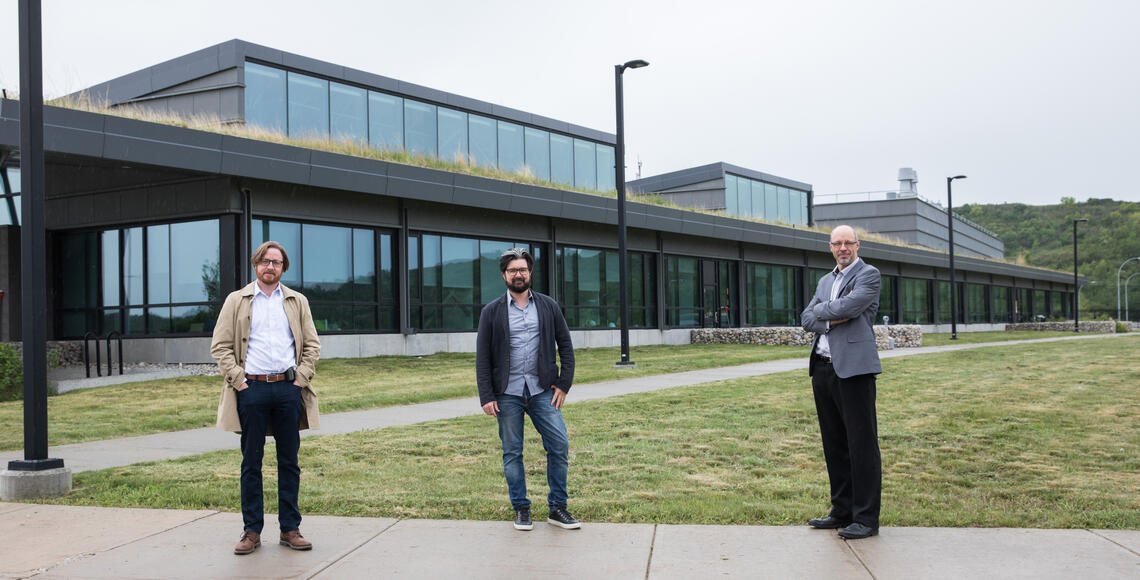Researchers awarded $6M to expand successful COVID-19 wastewater monitoring program to detect a wider range of viruses


Riley Brandt, University of Calgary
Calgary researchers behind the hugely successful COVID-19 wastewater monitoring program and online COVID tracker are convinced of the potential of wastewater as a public health tool, and they’re not alone.
Genome Canada, through regional partner Genome Alberta, has awarded the research group $2M through their Genomic Applications Partnership Program (GAPP) to investigate the potential of wastewater monitoring to detect and track more viruses, in partnership with Alberta Health. An additional combined $4M in funding for the project was awarded by Alberta Health, Genome Quebec, and the Government of Canada.
“Our Genome Canada project will use our wastewater testing platform to study and develop monitoring for other pathogens, while continuing to track COVID-19,” says Dr. Casey Hubert, PhD, professor of geomicrobiology in the Faculty of Science. “Wastewater samples offer an inclusive and non-biased way to study population health, making this monitoring an economical and effective tool for early detection of infection transmission, enabling mitigation and prevention of outbreaks.”


Bautista, left, and Janine McCalder, MSc student, examine wastewater samples.
Riley Brandt, University of Calgary
Extent of viruses in wastewater and what their presence means not fully known yet
In the early stages of the wastewater monitoring program, fuelled by the urgency of the pandemic, a team led by Hubert, Kevin Frankowski (Advancing Canadian Water Assets) and Dr. Michael Parkins, MD (Cumming School of Medicine), were laser focused on gathering data to help answer key questions being asked by public health officials. Are people getting sick? Where? Is the number of cases trending up or down?
Three years later, with robust systems in place, including the popular COVID tracker hosted by the Cumming School of Medicine Centre for Health Informatics, researchers have capacity to ask some bigger picture questions. What more can we find in the wastewater? Is this information useful? How else can we help?
“People have been checking wastewater for evidence of enteric viruses found in the gastrointestinal system, like norovirus and poliovirus, for decades, but you would not necessarily expect to find respiratory viruses,” says Dr. Maria Bautista, PhD. “Discovering that we can use wastewater to monitor respiratory viruses like SARS-CoV-2 has broadened what we think we can observe and track using this method.”
Bautista, virologist and senior research associate in the Faculty of Science, is part of the team using “the power of genomics” to figure out what else is in wastewater samples. They will be looking for genetic evidence of key viruses, including measles, mumps, and human papillomavirus (HPV), among others.


Michael Parkins, Casey Hubert, and Kevin Frankowski lead the COVID-19 wastewater monitoring team.
Adrian Shellard, for the University of Calgary
“When SARS-CoV-2 is in your body, making you sick, the virus is intact. But when it’s leaving your body in feces, it has broken down and what we are looking at are fragments of the virus’s genome. The genes are what we’re tracking in wastewater,” says Bautista. “To do this same process with other viruses, first we need to figure out what other viruses either in feces or urine we can detect. We don’t know what all viruses are in wastewater yet.”
“All” might sound like a lot, and it is. Wastewater samples contain all sorts of genetic material, much of it irrelevant to researchers. Human and plant DNA, parasites, bacteria, and viruses that don’t infect humans are all in the mix, along with those tiny pieces of genetic information that Bautista is looking for, a.k.a. “genomic targets”.
“Metagenomics will give us an inventory of all the things that are in the wastewater,” Bautista explains. “We have to sort through all of it and identify the viral information, clean it up, and then identify what viruses we have.”
The team will progressively refine their process to focus on the genomic targets they’re most interested in. “It’s a lot of data analysis, but that’s the fun part. You don’t necessarily know what you’re going to find,” she says.
Learning from the past to prepare for the future
The team is optimistic that wastewater monitoring can offer public health officials and citizens evidence they can use in the event of future outbreaks of other viruses. The project’s overarching goal is to have wastewater monitoring included in Alberta’s public health policy.
“As we know from the profound effects of the COVID-19 pandemic, early warning surveillance systems that governments and public health authorities can react to are extremely valuable,” says Hubert. “A key part of this project is to develop sample processing methods for viruses that are deemed high priority by our clinical partners, like we have already achieved with influenza and RSV.” Influenza and RSV (respiratory syncytial virus) were added to the online COVID tracker in 2022.
“Developing additional versatile methods that cover a wide range of genomic targets will better prepare Alberta Health for contending with future epidemics, pandemics and even endemic disease using wastewater monitoring,” says Hubert.
Additional Genome Canada funding awarded
Genome Canada has also funded a GAPP project led by Dr. Pere Santamaria, MD, PhD, professor in the Cumming School of Medicine. His project, in partnership with Parvus Therapeutics, will examine the use of Navacims to halt and cure autoimmune diseases, and aim to expand the commercial and clinical potential of this research. Learn more about Parvus Therapeutics and Santamaria’s lifelong journey to medical discovery.







































